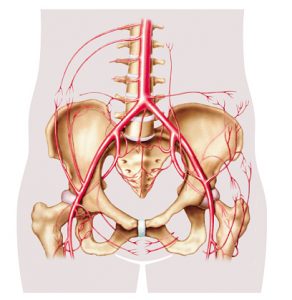 Leriche syndrome, also known as aortoiliac occlusive disease, is characterized by the blockage of the abdominal aorta as it transitions into the common iliac arteries. Leriche syndrome is considered a form of peripheral artery disease, as it is characterized by a narrowing of the arteries other than those that supply the heart or the brain.
Leriche syndrome, also known as aortoiliac occlusive disease, is characterized by the blockage of the abdominal aorta as it transitions into the common iliac arteries. Leriche syndrome is considered a form of peripheral artery disease, as it is characterized by a narrowing of the arteries other than those that supply the heart or the brain.
The abdominal aorta is the largest artery in the abdominal cavity and supplies blood to many of our vital internal organs and other tissue via its many branches. The common iliac arteries are comprised of two large branches and many diverging branches to provide blood to the pelvis and lower limb.
Advertisement
Causes of Leriche syndrome
The primary cause of Leriche syndrome is an atherosclerotic disease of the aorta. This is a condition of the arteries that make them become narrower due to plaque buildup. Atherosclerosis is considered a condition that affects older individuals as it takes years for a big enough plaque to develop. Arterial plaque is typically made up of calcium, fat, cholesterol, and other substances found in your blood. Atherosclerosis can also cause arteries to become stiff, causing restricted blood flow.
Other possible causes of Leriche syndrome include:
- Takayasu’s arteritis – an inflammatory condition in the arteries that can cause blockage
- Radiation to the pelvis – can cause progressive inflammation in the arterial wall leading to blockage
- Thrombosis
- Emboli
- Congenital diseases – includes aplasia and hypoplasia
Symptoms of Leriche syndrome
Leriche syndrome symptoms vary depending on the degree of vessel occlusion, with some patients not showing any symptoms at all. However, since the abdominal aorta and its many branches supply oxygenated blood to many important structures, symptoms will be apparent when they do present themselves. Often times, patients with Leriche syndrome will have intermittent symptoms that resolve soon after they develop. These symptoms can include:
- Fatigue of both lower limbs
- Leg weakness or numbness
- Muscle cramping pain in the thigh, hips, and buttocks (intermittent claudication)
- Erectile difficulty in men
- Weak pulse in femoral arteries
- Cold and pale extremities
- Ulcers on lower leg
- Gangrene of the toes and lower leg
The condition will often first manifest itself as not being able to walk for long distances, with even short distances becoming a challenge. Patients may then start to notice that the skin on their legs and feet begin to appear drier and scaly. A loss of lower leg hair may also be seen due to poor blood supply. Later stages of Leriche syndrome tend to be destructive, as toes begin to hurt and pain becomes more permanent. If Leriche syndrome treatment is not sought out right away at this point, significant cell damage and death may occur.
Diagnosis of Leriche syndrome
Diagnosis will often begin with a detailed description of your past medical history and currently presenting symptoms. This is to allow the doctor to differentiate between several other causes that may present in a similar fashion. Next, a physical exam will take place, which will allow the doctor to evaluate the condition of the affected skin, muscle mass, and temperature of the extremities. Documenting the pulses of the lower extremities is also very important for peripheral artery diseases such as this. Pulse areas that are checked include the radial, brachial, femoral, and popliteal.
Once a suspected diagnosis of Leriche syndrome has been made, more accurate diagnostic testing will be in order. Initially, testing will include taking an ankle-brachial index and a duplex ultrasound. These tests will give a good first evaluation that can be confirmed using more accurate testing.
Further testing often includes imaging tests using computed tomography (CT) angiography, which combines an injection of contrast media and the imaging scan to get a better look at the vessels of the body. CT angiography is a great test to visualize and assess the site of occlusion and stenosis. A magnetic resonance angiography (MRA) may be substituted if a CT is not possible.
Treatment for Leriche syndrome
Correcting and restoring blood supply to affected areas by enhancing vascularization is the goal of treatment in Leriche syndrome. This may take many forms:
- Treating underlying risk factors: Treating pre-existing conditions such as hyperlipidemia, diabetes, and hypertension and keeping them under control will help reduce the chances of developing peripheral artery disease. Staying healthy by eating a balanced diet and quitting bad habits such as smoking cigarettes will also help to reduce the chances of developing atherosclerosis.
- Supportive treatment: Involves staying active and performing various exercises that aim to boost the use of oxygen by muscles in the lower extremities. This may include walking, running, or other exercises that involve the legs.
- Medical intervention: If none of the previously mentioned treatments have proven successful, the use of drugs to relieve claudication may be recommended. Pentoxifylline and Cilostazol are two commonly used drugs in the treatment of peripheral artery disease. Medications to reduce clotting may also be implemented depending on the circumstance
- Surgical intervention: May involve procedures such as aortoiliac endarterectomy, percutaneous transluminal angioplasty with or without stent placement, aorto-bifemoral bypass, axillary-bi-femoral and femoral-femoral bypass. These procedures aim to either remove the occasion or create a bypass around it.
Advertisement
Prevention of Leriche syndrome
The best way to prevent the development of Leriche syndrome is to not expose yourself to the risk factors that cause it in the first place. This will require you to stop smoking and manage chronic underlying conditions such as diabetes, cholesterol, and high blood pressure.
It is also recommended to eat a healthy well-balanced diet that is low in fat and cholesterol while getting regular exercise.
